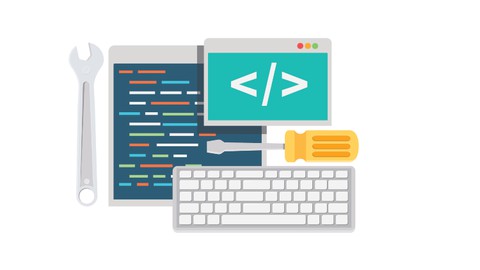
Create a Notepad Application with C# and Visual Studio
Create a Notepad Application with C# and Visual Studio, available at $27.99, has an average rating of 4.1, with 21 lectures, based on 26 reviews, and has 2349 subscribers.
You will learn about Setup Development Environment Create a new Windows Forms Project Add Widgets to Windows Forms Project Modify Widget Properties Write logic application logic Build a Notepad Application This course is ideal for individuals who are Beginners to Windows Forms Application Development It is particularly useful for Beginners to Windows Forms Application Development.
Enroll now: Create a Notepad Application with C# and Visual Studio
Summary
Title: Create a Notepad Application with C# and Visual Studio
Price: $27.99
Average Rating: 4.1
Number of Lectures: 21
Number of Published Lectures: 21
Number of Curriculum Items: 21
Number of Published Curriculum Objects: 21
Original Price: $19.99
Quality Status: approved
Status: Live
What You Will Learn
- Setup Development Environment
- Create a new Windows Forms Project
- Add Widgets to Windows Forms Project
- Modify Widget Properties
- Write logic application logic
- Build a Notepad Application
Who Should Attend
- Beginners to Windows Forms Application Development
Target Audiences
- Beginners to Windows Forms Application Development
Windows Notepad is a simple text editor for Windows; it creates and edits plain text documents.
C# (pronounced “See Sharp”) is a modern, object-oriented, and type-safe programming language. C# enables developers to build many types of secure and robust applications that run in .NET. C# has its roots in the C family of languages and will be immediately familiar to C, C++, Java, and JavaScript programmers. This tour provides an overview of the major components of the language in C# 8 and earlier.
C# programs consist of one or more files. Each file contains zero or more namespaces. A namespace contains types such as classes, structs, interfaces, enumerations, and delegates, or other namespaces.
C# is an object-oriented, component-oriented programming language. C# provides language constructs to directly support these concepts, making C# a natural language in which to create and use software components. Since its origin, C# has added features to support new workloads and emerging software design practices. At its core, C# is an object-oriented language. You define types and their behavior.
Microsoft Visual Studio is an integrated development environment from Microsoft. It is used to develop computer programs, as well as websites, web apps, web services and mobile apps.
Windows Forms is a free and open-source graphical class library included as a part of Microsoft .NET, .NET Framework or Mono Framework, providing a platform to write client applications for desktop, laptop, and tablet PCs.
Course Curriculum
Chapter 1: Setup Development Environment
Lecture 1: Introduction
Lecture 2: What is C#
Lecture 3: What is Visual Studio
Lecture 4: Minimum installation requirements for visual studio
Lecture 5: Visual studio workloads
Lecture 6: Installing Visual Studio
Chapter 2: Creating a Notepad Application
Lecture 1: Project Introduction
Lecture 2: Creating a new project in visual studio
Lecture 3: Adding Widgets
Lecture 4: Changing properties for widgets : part 1
Lecture 5: Changing properties for widgets : part 2
Lecture 6: Changing properties for widgets : part 3
Lecture 7: Writing some code logic
Lecture 8: Writing the code for menu controls
Lecture 9: Testing what we have done so far
Lecture 10: Setting breakpoints
Lecture 11: Writing code to load files
Lecture 12: Writing code to save files
Lecture 13: Create a ne window : part 1
Lecture 14: Create a ne window : part 2
Lecture 15: Building on what we have done
Instructors
-
Bluelime Learning Solutions
Making Learning Simple
Rating Distribution
- 1 stars: 1 votes
- 2 stars: 1 votes
- 3 stars: 3 votes
- 4 stars: 9 votes
- 5 stars: 12 votes
Frequently Asked Questions
How long do I have access to the course materials?
You can view and review the lecture materials indefinitely, like an on-demand channel.
Can I take my courses with me wherever I go?
Definitely! If you have an internet connection, courses on Udemy are available on any device at any time. If you don’t have an internet connection, some instructors also let their students download course lectures. That’s up to the instructor though, so make sure you get on their good side!
You may also like
- Top 10 Video Editing Courses to Learn in November 2024
- Top 10 Music Production Courses to Learn in November 2024
- Top 10 Animation Courses to Learn in November 2024
- Top 10 Digital Illustration Courses to Learn in November 2024
- Top 10 Renewable Energy Courses to Learn in November 2024
- Top 10 Sustainable Living Courses to Learn in November 2024
- Top 10 Ethical AI Courses to Learn in November 2024
- Top 10 Cybersecurity Fundamentals Courses to Learn in November 2024
- Top 10 Smart Home Technology Courses to Learn in November 2024
- Top 10 Holistic Health Courses to Learn in November 2024
- Top 10 Nutrition And Diet Planning Courses to Learn in November 2024
- Top 10 Yoga Instruction Courses to Learn in November 2024
- Top 10 Stress Management Courses to Learn in November 2024
- Top 10 Mindfulness Meditation Courses to Learn in November 2024
- Top 10 Life Coaching Courses to Learn in November 2024
- Top 10 Career Development Courses to Learn in November 2024
- Top 10 Relationship Building Courses to Learn in November 2024
- Top 10 Parenting Skills Courses to Learn in November 2024
- Top 10 Home Improvement Courses to Learn in November 2024
- Top 10 Gardening Courses to Learn in November 2024






















